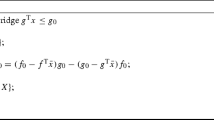Abstract
In this paper we develop simple index-based graph-partitioning techniques. We show that our methods are very fast and provide good-quality mappings. We also show that they are easily parallelizable. These properties make them useful for the parallelization of a number of irregular and adaptive applications.
Similar content being viewed by others
References
I. Angus, G. Fox, J. Kim, and D. Walker. Solving Problems on Concurrent Processors, volume 2. Prentice-Hall, Englewood Cliffs, N.J., 1990.
S. Barnard and H. Simon. A fast multilevel implementation of recursive spectral bisection for partitioning unstructured problems. In Proceedings of the 6th SIAM Conference, pages 711–718, 1993.
M. Berger and S. Bokhari. A partitioning strategy for nonuniform problems on multiprocessors. IEEE Trans., 36:570–580, May 1987.
M. Bolorforoush, N. Coleman, D. Quammen, and P. Wang. A parallel randomized sorting algorithm. In Proceedings of the International Conference on Parallel Processing, August 1992.
Z. Bozkus, S. Ranka, and G. Fox. Benchmarking the CM-5 multicomputer. In Proceedings of the Frontiers of Massively Parallel Computation, 1992.
B. Brooks, R. Bruccoleri, B. Olafson, D.J. States, S. Swaminathan, and M. Karplus. A program for macromolecular energy, minimization, and dynamics calculations. Journal of Computational Chemistry, 4:187, 1983.
A. Choudhary, G. Fox, S. Hiranandani, K. Kennedy, C. Koelbel, S. Ranka, and J. Saltz. Software support for irregular and loosely synchronous problems. In Proceedings of the Conference on High Performance Computing for Flight Vehicles, pages 43–52, 1992.
A. Choudhary, G. Fox, S. Hiranandani, K. Kennedy, C. Koelbel, S. Ranka, and C. Tseng. Compiling Fortran 77D and 90D for MIMD distributed-memory machines. In Proceedings of the Frontiers of Massively Parallel Computation, pages 4–11,1992.
P. Coddington and C. Baillie. Cluster algorithms for spin models on MIMD parallel computers. In Proceedings of the 5th Distributed Memory Computing Conference, pages 384–388, Charleston, S.C., April 1990.
N. Copty, S. Ranka, G. Fox, and R. Shankar. SIMD and MIMD region growing algorithms on the CM-5. In International Conference on Parallel Processing, pages 102–105,1994.
F. Ercal. Heuristic approaches to task allocation for parallel computing. Ph.D. thesis, Ohio State University, 1988.
G. Fox. Graphical approach to load balancing and sparse matrix vector multiplication on the hypercube. 1988. Ed. M. Schultz, Springer-Verlag, Berlin.
G. Fox. The architecture of problems and portable parallel software systems. Technical report, Syracuse University, July 1991.
G. Fox and W. Furmanski. Load balancing loosely synchronous problems with a neural network. In Proceedings, Third Conference on Hypercube Concurrent Comptuers and Applications, pages 241–278, 1988.
G. Fox, M. Johnson, G. Lyzenga, S. Otto, J. Salmon, and D. Walker. Solving Problems on Concurrent Processors, volume 1. Prentice Hall, Englewood Cliffs, N.J., 1988.
M. Garey and D. Johnson. Computers and Intractability, pages 209–210, Freeman, 1978.
J. Gilbert, G. Miller, and S. Teng. A geometric approach to mesh partitioning: Implementation and experiments. Technical report, Xerox Palo Alto Research Center, 1992.
B. Hendrickson and R. Leland. A multilevel algorithm for partitioning graphs. Technical report, Sandia National Laboratories, Albuquerque, N.Mex., 87185, 1993.
B. Hendrickson and R. Leland. An improved spectral load balancing method. In Proceedings of 6th SIAM Conference, pages 953–961, 1993.
B. Hendrickson and R. Leland. Multidimensional spectral load balancing. Technical report, Sandia National Laboratories, Albuquerque, N.Mex., 1993.
B. Hendrickson and R. Leland. The Chaco user's guide, version 1.0. Technical report, Sandia National Laboratories, October 1993.
Z. Johan, K. Mathur, S. Johnsson, and T. Hughes. An efficient communication strategy for finite element methods on c the Connection Machine CM-5 system. Technical report, Thinking Machines Corporation.
H. Maini, K. Mehrotra, C. Mohan, and S. Ranka. Genetic algorithms for graph partitioning and incremental graph partitioning. In Proceedings of Supercomputing '94, November 1994.
N. Mansour. Physical optimization algorithms for mapping data to distributed-memory multiprocessors. Ph.D. thesis, Syracuse University, N.Y., 1993.
G. Miller, S. Teng, W. Thurston, and S. Vavasis. Automatic mesh partitioning. In Proceedings of the 1992 Workshop on Sparse Matrix Computations: Graph Theory Issues and Algorithms, Institute for Mathematics and its Applications, 1992.
C. Ou and S. Ranka. Parallel remapping algorithms for adaptive problems. In Frontiers '95, pages 367–374, 1995.
C. Ou, S. Ranka, and G. Fox. Fast mapping and remapping algorithm for irregular and adaptive problems. In Proceedings of the 1993 International Conference on Parallel and Distributed Systems, pages 279–283, Taipei, Taiwan, December 1993.
A. Pothen, H. Simon, and K. Liou. Partitioning sparse matrices with eigenvectors of graphs. SIAM Journal of Matrix Analysis and Application, 11:430–352, July 1990.
J. Quirk. An adaptive grid algorithm for computational shock hydrodynamics. Ph.D. thesis, Cranfield Institute of Technology, United Kingdom, 1991.
S. Ranka, Y. Won, and S. Sahni. Programming a hypercube multicomputer. IEEE Software: 69–77, September 1988.
R. Shankar and S. Ranka. Hypercube algorithms for quadtree operations. Journal of Pattern Recognition, 25(7): 741–747, September 1992.
R. Shankar and S. Ranka. Computer vision algorithms for sparse images. Journal of Pattern Recognition, 26:1511–1519, October 1993.
R. Shankar, S. Ranka, and K. Alsabti. Many-to-many personalized communication with bounded traffic. In Frontiers '95, pages 20–27, 1995.
H. Shi and J. Schaeffer. Parallel sorting by regular sampling. Journal of Parallel and Distributed Computing, 14:361–372, 1992.
H. Simon. Partitioning of unstructured mesh problems for parallel processing. In Proceedings of the Conference on Parallel Methods on Large Scale Structural Analysis and Physics Applications. Permagon Press, 1991.
C. Thompson and H. Kung. Sorting on a mesh-connected parallel computer. Communicatios of the ACM, 20:263–271, 1977.
G. Warren, W. Anderson, J. Thomas, and T. Roberts. Grid convergence for adaptive methods. In Proceedings of the AIAA 10th Computational Fluid Dynamics Conference, page 1591, June 1991.
M. Warren and J. Salmon. Astrophysical N-body simulations using hierarchical tree data structure. In Proceedings, Supercomputing '92, Minneapolis, November 1992.
R. Williams. DIME: Distributed irregular mesh enviroment. Technical report, California Institute of Technology, February 1990.
R. Williams. Performance of dynamic load-balancing algorithm for unstructured mesh calculations. Concurrency: Practice and Experience, 3:457–481, 1991.




